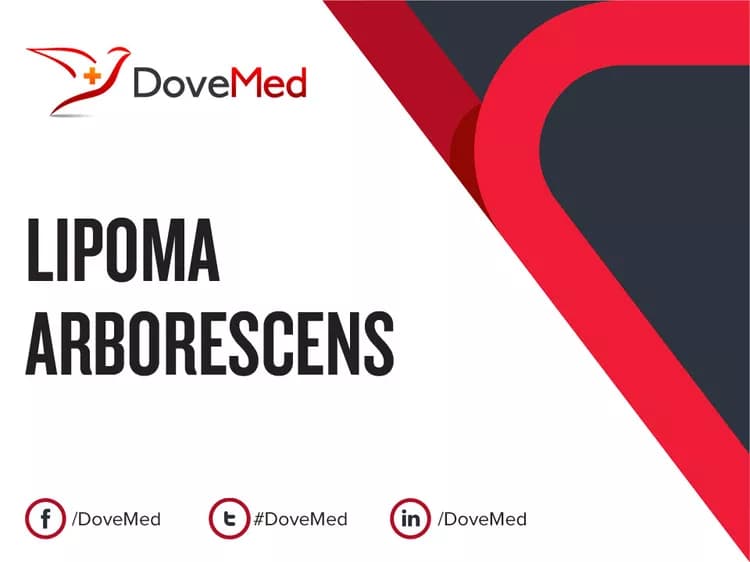What are the other Names for this Condition? (Also known as/Synonyms)
- Diffuse Lipoma of Joint
- Diffuse Synovial Lipoma
- Fatty Infiltration of Synovial Membrane
What is Lipoma Arborescens? (Definition/Background Information)
- Lipoma Arborescens is a rare benign condition, where the synovium (a protective layer surrounding the joint space) is replaced by fatty tissue. This replacement results in finger-like growth of the synovial tissue
- It is often seen around the knee joint. The disorder causes pain, swelling and decreased range of movement in the joints. Even though commonly seen around the knee joint, other joints of the body may be affected too
- A tissue biopsy helps in a definitive diagnosis of the condition, which is treated using both conservative methods and surgical procedures
- With appropriate treatment, the prognosis of Lipoma Arborescens is good
Who gets Lipoma Arborescens? (Age and Sex Distribution)
- Lipoma Arborescens is a rare condition, which usually occurs in the 5th to 7th decade of life
- Both men and women are affected by it. Some studies have shown that this condition is slightly more common in men, while other studies show an equal frequency for both male and female sexes
What are the Risk Factors for Lipoma Arborescens? (Predisposing Factors)
Some of the risk factors associated with Lipoma Arborescens include:
- Chronic rheumatoid arthritis
- Repeated trauma to the affected joints; a previous trauma
- Psoriasis
- Presence of baker’s cyst
- Osteoarthritis of the joints
It is important to note that having a risk factor does not mean that one will get the condition. A risk factor increases ones chances of getting a condition compared to an individual without the risk factors. Some risk factors are more important than others.
Also, not having a risk factor does not mean that an individual will not get the condition. It is always important to discuss the effect of risk factors with your healthcare provider.
What are the Causes of Lipoma Arborescens? (Etiology)
- Lipoma Arborescens is considered to be a reactive condition rather than a neoplastic condition
- It is caused by repeated trauma or repeated inflammation of the synovium, due to a variety of reasons
What are the Signs and Symptoms of Lipoma Arborescens?
The signs and symptoms of Lipoma Arborescens include:
- Pain in the affected joints
- The condition can cause an accumulation of joint fluid, called a reactive joint effusion, due to repeated injury of the synovial layer that surrounds a joint
- Swelling of the joint
- Restricted or decreased range of motion in the affected joints
- Most commonly the condition is observed in the knee joint, but other joints, such as the hip, shoulder, wrist, and elbow may also be affected
Lipoma Arborescens usually affects a single joint; but in rare cases, multiple joints may be affected.
How are Lipoma Arborescens Diagnosed?
A diagnosis of Lipoma Arborescens may involve:
- A physical examination and evaluation of complete medical history
- X-ray of knee joint (or the affected joint)
- MRI scan of the affected joint, which shows presence of fatty tissue within the synovial membrane and other characteristic features
- An ultrasound of the joint will help determine the presence of fluid in the joints (if any)
- A tissue biopsy, where the tissue is examined by a pathologist under the microscope, to arrive at a definitive diagnosis. The tissue biopsy is performed using arthroscopic techniques
Many clinical conditions may have similar signs and symptoms. Your healthcare provider may perform additional tests to rule out other clinical conditions to arrive at a definitive diagnosis.
What are the possible Complications of Lipoma Arborescens?
The possible complications from Lipoma Arborescens include:
- If treatment is lacking or is not provided in a timely manner, then the condition can progress to cause damage to the affected joint
- Severe symptoms (pain, inflammation) in the joints can decrease the quality of one’s life
How are Lipoma Arborescens Treated?
A treatment of Lipoma Arborescens may include:
- Treating the underlying conditions, such as rheumatoid arthritis, osteoarthritis
- Decreasing or stopping any activity that cause repetitive trauma to the synovium
- Use of pain medication
- Treating the joint effusion by removing fluid through needle aspiration
- Synovectomy, which is the surgical removal of affected synovial tissue. This procedure can cure the condition
How can Lipoma Arborescens be Prevented?
Lipoma Arborescens is a benign condition that may not be preventable. However, the following measures may help in keeping the condition under control:
- Undertaking appropriate treatment for the underlying condition such as arthritis, psoriasis, baker’s cyst, etc.
- Avoiding any physical activity that can cause repeated or continuous injury to any of the joints
- If a diagnosis of Lipoma Arborescens is made, then considering a reduction (or complete cessation of) physical activities can help decrease progression of the condition
- If there is repeated pain around the affected joint, it is important to visit the physician immediately
What is the Prognosis of Lipoma Arborescens? (Outcomes/Resolutions)
- The prognosis of Lipoma Arborescens is generally very good with surgical treatment
- Proper treatment of the underlying conditions, such as rheumatoid arthritis and osteoarthritis, may have to be taken
- A lack of treatment or delayed treatment may cause additional complications such as prolonged pain and joint damage
Additional and Relevant Useful Information for Lipoma Arborescens:
The following article links will help you understand rheumatoid arthritis and psoriasis.
https://www.dovemed.com/diseases-conditions/rheumatoid-arthritis-ra/
Related Articles
Test Your Knowledge
Asked by users
Related Centers
Related Specialties
Related Physicians
Related Procedures
Related Resources
Join DoveHubs
and connect with fellow professionals



0 Comments
Please log in to post a comment.